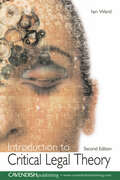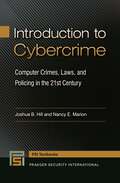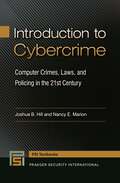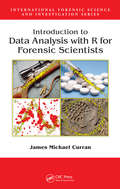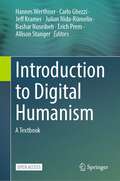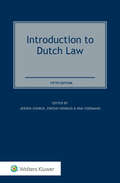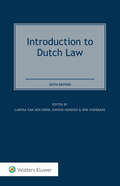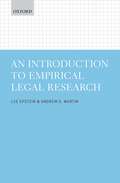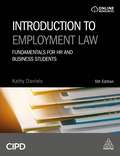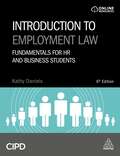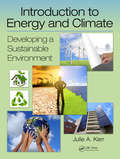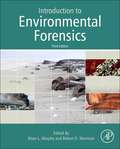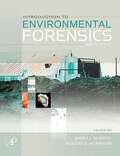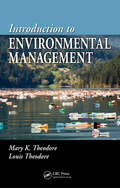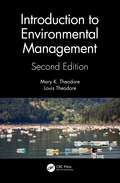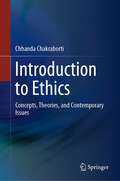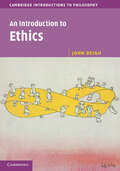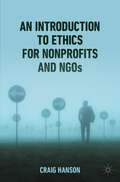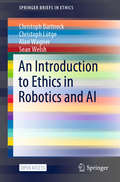- Table View
- List View
Introduction to Critical Legal Theory
by Ian WardIntroduction to Critical Legal Theory provides an accessible introduction to the study of law and legal theory. It covers all the seminal movements in classical, modern and postmodern legal thought, engaging the reader with the ideas of jurists as diverse as Aristotle, Hobbes and Kant, Marx, Foucault and Dworkin. At the same time, it impresses the interdisciplinary nature of critical legal thought, introducing the reader to the philosophy, the economics and the politics of law. This new edition focuses even more intently upon the narrative aspect of critical legal thinking and the re-emergence of a distinctive legal humanism, as well as the various related challenges posed by our 'new' world order. Introduction to Critical Theory is a comprehensive text for both students and teachers of legal theory, jurisprudence and related subjects.
Introduction to Cybercrime: Computer Crimes, Laws, and Policing in the 21st Century (Praeger Security International Textbook)
by Joshua B. Hill Nancy E. MarionExplaining cybercrime in a highly networked world, this book provides a comprehensive yet accessible summary of the history, modern developments, and efforts to combat cybercrime in various forms at all levels of government—international, national, state, and local.As the exponential growth of the Internet has made the exchange and storage of information quick and inexpensive, the incidence of cyber-enabled criminal activity—from copyright infringement to phishing to online pornography—has also exploded. These crimes, both old and new, are posing challenges for law enforcement and legislators alike. What efforts—if any—could deter cybercrime in the highly networked and extremely fast-moving modern world? Introduction to Cybercrime: Computer Crimes, Laws, and Policing in the 21st Century seeks to address this tough question and enables readers to better contextualize the place of cybercrime in the current landscape.This textbook documents how a significant side effect of the positive growth of technology has been a proliferation of computer-facilitated crime, explaining how computers have become the preferred tools used to commit crimes, both domestically and internationally, and have the potential to seriously harm people and property alike. The chapters discuss different types of cybercrimes—including new offenses unique to the Internet—and their widespread impacts. Readers will learn about the governmental responses worldwide that attempt to alleviate or prevent cybercrimes and gain a solid understanding of the issues surrounding cybercrime in today's society as well as the long- and short-term impacts of cybercrime.
Introduction to Cybercrime: Computer Crimes, Laws, and Policing in the 21st Century (Praeger Security International Textbook)
by Joshua B. Hill Nancy E. MarionExplaining cybercrime in a highly networked world, this book provides a comprehensive yet accessible summary of the history, modern developments, and efforts to combat cybercrime in various forms at all levels of government—international, national, state, and local.As the exponential growth of the Internet has made the exchange and storage of information quick and inexpensive, the incidence of cyber-enabled criminal activity—from copyright infringement to phishing to online pornography—has also exploded. These crimes, both old and new, are posing challenges for law enforcement and legislators alike. What efforts—if any—could deter cybercrime in the highly networked and extremely fast-moving modern world? Introduction to Cybercrime: Computer Crimes, Laws, and Policing in the 21st Century seeks to address this tough question and enables readers to better contextualize the place of cybercrime in the current landscape.This textbook documents how a significant side effect of the positive growth of technology has been a proliferation of computer-facilitated crime, explaining how computers have become the preferred tools used to commit crimes, both domestically and internationally, and have the potential to seriously harm people and property alike. The chapters discuss different types of cybercrimes—including new offenses unique to the Internet—and their widespread impacts. Readers will learn about the governmental responses worldwide that attempt to alleviate or prevent cybercrimes and gain a solid understanding of the issues surrounding cybercrime in today's society as well as the long- and short-term impacts of cybercrime.
Introduction to Data Analysis with R for Forensic Scientists
by James Michael CurranStatistical methods provide a logical, coherent framework in which data from experimental science can be analyzed. However, many researchers lack the statistical skills or resources that would allow them to explore their data to its full potential. Introduction to Data Analysis with R for Forensic Sciences minimizes theory and mathematics and focus
Introduction to Digital Humanism: A Textbook
by Hannes Werthner Carlo Ghezzi Jeff Kramer Julian Nida-Rümelin Bashar Nuseibeh Erich Prem Allison StangerThis open access textbook introduces and defines digital humanism from a diverse range of disciplines. Following the 2019 Vienna Manifesto, the book calls for a digital humanism that describes, analyzes, and, most importantly, influences the complex interplay of technology and humankind, for a better society and life, fully respecting universal human rights. The book is organized in three parts: Part I “Background” provides the multidisciplinary background needed to understand digital humanism in its philosophical, cultural, technological, historical, social, and economic dimensions. The goal is to present the necessary knowledge upon which an effective interdisciplinary discourse on digital humanism can be founded. Part II “Digital Humanism – a System’s View” focuses on an in-depth presentation and discussion of the main digital humanism concerns arising in current digital systems. The goal of this part is to make readers aware and sensitive to these issues, including e.g. the control and autonomy of AI systems, privacy and security, and the role of governance. Part III “Critical and Societal Issues of Digital Systems” delves into critical societal issues raised by advances of digital technologies. While the public debate in the past has often focused on them separately, especially when they became visible through sensational events the aim here is to shed light on the entire landscape and show their interconnected relationships. This includes issues such as AI and ethics, fairness and bias, privacy and surveillance, platform power and democracy. This textbook is intended for students, teachers, and policy makers interested in digital humanism. It is designed for stand-alone and for complementary courses in computer science, or curricula in science, engineering, humanities and social sciences. Each chapter includes questions for students and an annotated reading list to dive deeper into the associated chapter material. The book aims to provide readers with as wide an exposure as possible to digital advances and their consequences for humanity. It includes constructive ideas and approaches that seek to ensure that our collective digital future is determined through human agency.
Introduction to Dutch Law
by Jeroen Chorus Ewoud Hondius Wim VoermansA standard legal resource since its first edition in 1978, this matchless book has proven itself the ideal overview of Dutch law for foreign lawyers. This Fifth Edition fully updates its systematic description of the legal sources, institutions, and concepts in all major fields of law. Recent developments covered include the progressive implementation of standards set by international conventions, the reorganization of the judiciary, the statute on environmental law, and the (re)codification of private international law. The continuing influence of European law is evident in many fields, perhaps most notably in family law. The various chapters are written by experts – scholars and lawyers – in particular fields, and provide an authoritative overview of each field. The historical sources of Dutch law are discussed, as well as Dutch legal culture, judicial organization, legal education, and the legal profession. These chapters are followed by introductions to essential issues of private and public law and labour law. The last chapter examines questions of legal philosophy. The only resource of its kind available, this book is unmatched as a thorough guide to further research. It offers practitioners, particularly foreign lawyers, a quick and reliable way into any area of Dutch law that they may be required to research. It will also be of great value to comparatists (especially those studying the influence of European law on national legal systems), scholars, and students. Like previous editions, the Fifth Edition has been prepared under the auspices of the Netherlands Comparative Law Association.
Introduction to Dutch Law
A standard legal resource since its first edition in 1978, this matchless book has proven itself the ideal overview of Dutch law for foreign lawyers. This Sixth Edition fully updates its systematic description of the legal sources, institutions, and concepts in all major fields of law. Recent developments covered include the progressive implementation of standards set by international conventions, the reorganization of the judiciary, the statute on environmental law, and the (re)codification of private international law. The continuing influence of European law is evident in many fields, perhaps most notably in family law. The various chapters are written by experts – scholars and lawyers – in particular fields, and provide an authoritative overview of each field. The historical sources of Dutch law are discussed, as well as Dutch legal culture, legal philosophy, judicial organization, legal education, and the legal profession. These chapters are followed by introductions to essential issues of private and public law and labour law. The last chapter examines financial law. The only resource of its kind available, this book is unmatched as a thorough guide to further research. It offers practitioners, particularly foreign lawyers, a quick and reliable way into any area of Dutch law that they may be required to research. It will also be of great value to comparatists (especially those studying the influence of European law on national legal systems), scholars, and students. Like previous editions, the Sixth Edition has been prepared under the auspices of the Netherlands Comparative Law Association.
An Introduction to Empirical Legal Research
by Lee Epstein Andrew D. MartinIs the death penalty a more effective deterrent than lengthy prison sentences? Does a judge's gender influence their decisions? Do independent judiciaries promote economic freedom? Answering such questions requires empirical evidence, and arguments based on empirical research have become an everyday part of legal practice, scholarship, and teaching. In litigation judges are confronted with empirical evidence in cases ranging from bankruptcy and taxation to criminal law and environmental infringement. In academia researchers are increasingly turning to sophisticated empirical methods to assess and challenge fundamental assumptions about the law. As empirical methods impact on traditional legal scholarship and practice, new forms of education are needed for today's lawyers. All lawyers asked to present or assess empirical arguments need to understand the fundamental principles of social science methodology that underpin sound empirical research. An Introduction to Empirical Legal Research introduces that methodology in a legal context, explaining how empirical analysis can inform legal arguments; how lawyers can set about framing empirical questions, conducting empirical research, analysing data, and presenting or evaluating the results. The fundamentals of understanding quantitative and qualitative data, statistical models, and the structure of empirical arguments are explained in a way accessible to lawyers with or without formal training in statistics. Written by two of the world's leading experts in empirical legal analysis, drawing on years of experience in training lawyers in empirical methods, An Introduction to Empirical Legal Research will be an invaluable primer for all students, academics, or practising lawyers coming to empirical research - whether they are embarking themselves on an empirical research project, or engaging with empirical arguments in their field of study, research, or practice.
An Introduction to Empirical Legal Research
by Lee Epstein Andrew D. MartinIs the death penalty a more effective deterrent than lengthy prison sentences? Does a judge's gender influence their decisions? Do independent judiciaries promote economic freedom? Answering such questions requires empirical evidence, and arguments based on empirical research have become an everyday part of legal practice, scholarship, and teaching. In litigation judges are confronted with empirical evidence in cases ranging from bankruptcy and taxation to criminal law and environmental infringement. In academia researchers are increasingly turning to sophisticated empirical methods to assess and challenge fundamental assumptions about the law. As empirical methods impact on traditional legal scholarship and practice, new forms of education are needed for today's lawyers. All lawyers asked to present or assess empirical arguments need to understand the fundamental principles of social science methodology that underpin sound empirical research. An Introduction to Empirical Legal Research introduces that methodology in a legal context, explaining how empirical analysis can inform legal arguments; how lawyers can set about framing empirical questions, conducting empirical research, analysing data, and presenting or evaluating the results. The fundamentals of understanding quantitative and qualitative data, statistical models, and the structure of empirical arguments are explained in a way accessible to lawyers with or without formal training in statistics. Written by two of the world's leading experts in empirical legal analysis, drawing on years of experience in training lawyers in empirical methods, An Introduction to Empirical Legal Research will be an invaluable primer for all students, academics, or practising lawyers coming to empirical research - whether they are embarking themselves on an empirical research project, or engaging with empirical arguments in their field of study, research, or practice.
Introduction to Employment Law: Fundamentals for HR and Business Students
by Kathy DanielsWritten specifically for HR and Business students, Introduction to Employment Law is a clear and accessible guide to employment law and how it applies in practice. Covering everything from employment tribunals and discrimination to redundancy and termination of employment, this textbook doesn't assume any prior knowledge of the UK legal system and equips students with all the knowledge and skills that they need to take forward into the workplace.Fully revised with all the latest cases and legal developments, this new edition includes coverage of hot topics such as defining employment status in the gig economy, gender pay reporting, the General Data Protection Regulation (GDPR) and the legal implications to be considered with Britain's withdrawal from the European Union. Packed with pedagogical features to consolidate learning including chapter objectives, tasks, 'explore further' sections, key learning points and examples to work through, as well as a dedicated study skills chapter, Introduction to Employment Law is essential reading for all students studying the CIPD Level 5 Intermediate module in employment law as well as being a useful resource for those studying at level 3 and an accessible introduction for level 7 and those on undergraduate and postgraduate courses needing a thorough grounding in employment law. Online resources include lecture slides, case studies, multiple choice questions, annotated weblinks and an instructor's manual.
Introduction to Employment Law: Fundamentals for HR and Business Students
by Kathy DanielsWritten specifically for HR and business students, Introduction to Employment Law is a clear, accessible and jargon-free guide to UK employment law and how it applies in practice. This book covers all the essentials of employment law including employment contracts, discrimination, redundancy and employment tribunals. There is also expert guidance on key issues including shared parental leave, flexible working policies and protected characteristics. Fully revised with the latest cases and legal developments, this new edition includes coverage of the rights of agency workers, bereavement leave, furlough practices and the legal implications of Brexit. This textbook doesn't assume any prior knowledge of the UK legal system and equips students with the knowledge and skills that they need to take forward into the workplace. Packed with pedagogical features to consolidate learning including tasks, examples, explore further sections and key learning points as well as a dedicated study skills chapter covering employment law assignments and exams, Introduction to Employment Law is essential reading for all students studying the CIPD Level 5 Intermediate module in employment law. It is also an accessible introduction for Level 7 students and those on undergraduate and postgraduate business courses needing a thorough grounding in employment law. Online resources include lecture slides, case studies, annotated weblinks and an instructor's manual.
Introduction to Energy and Climate: Developing a Sustainable Environment
by Julie KerrThe purpose of this textbook is to provide a well-rounded working knowledge of both climate change and environmental sustainability for a wide range of students. Students will learn core concepts and methods to analyze energy and environmental impacts; will understand what is changing the earth’s climate, and what that means for life on earth now and in the future. They will also have a firm understanding of what energy is and how it can be used. This text intends to develop working knowledge of these topics, with both technical and social implications. Students will find in one volume the integration and careful treatment of climate, energy, and sustainability.
Introduction to Energy and Climate: Developing a Sustainable Environment
by Julie KerrThe purpose of this textbook is to provide a well-rounded working knowledge of both climate change and environmental sustainability for a wide range of students. Students will learn core concepts and methods to analyze energy and environmental impacts; will understand what is changing the earth’s climate, and what that means for life on earth now and in the future. They will also have a firm understanding of what energy is and how it can be used. This text intends to develop working knowledge of these topics, with both technical and social implications. Students will find in one volume the integration and careful treatment of climate, energy, and sustainability.
Introduction to English Legal History
by John BakerFully revised and updated, this classic text provides the authoritative introduction to the history of the English common law. The book traces the development of the principal features of English legal institutions and doctrines from Anglo-Saxon times to the present and, combined with Baker and Milsom's Sources of Legal History, offers invaluable insights into the development of the common law of persons, obligations, and property, and also of criminal and public law. It is an essential reference point for all lawyers, historians and students seeking to understand the evolution of English law over a millennium. The book provides an introduction to the main characteristics, institutions, and doctrines of English law over the longer term - particularly the evolution of the common law before the extensive statutory changes and regulatory regimes of the last two centuries. It explores how legal change was brought about in the common law and how judges and lawyers managed to square evolution with respect for inherited wisdom.
Introduction to English Legal History
by John BakerFully revised and updated, this classic text provides the authoritative introduction to the history of the English common law. The book traces the development of the principal features of English legal institutions and doctrines from Anglo-Saxon times to the present and, combined with Baker and Milsom's Sources of Legal History, offers invaluable insights into the development of the common law of persons, obligations, and property, and also of criminal and public law. It is an essential reference point for all lawyers, historians and students seeking to understand the evolution of English law over a millennium. The book provides an introduction to the main characteristics, institutions, and doctrines of English law over the longer term - particularly the evolution of the common law before the extensive statutory changes and regulatory regimes of the last two centuries. It explores how legal change was brought about in the common law and how judges and lawyers managed to square evolution with respect for inherited wisdom.
Introduction to Environmental Forensics
by Brian L. Murphy Robert D. MorrisonThe third edition of Introduction to Environmental Forensics is a state-of-the-art reference for the practicing environmental forensics consultant, regulator, student, academic, and scientist, with topics including compound-specific isotope analysis (CSIA), advanced multivariate statistical techniques, surrogate approaches for contaminant source identification and age dating, dendroecology, hydrofracking, releases from underground storage tanks and piping, and contaminant-transport modeling for forensic applications. Recognized international forensic scientists were selected to author chapters in their specific areas of expertise and case studies are included to illustrate the application of these methods in actual environmental forensic investigations. This edition provides updates on advances in various techniques and introduces several new topics.Provides a comprehensive review of all aspects of environmental forensicsCoverage ranges from emerging statistical methods to state-of-the-art analytical techniques, such as gas chromatography-combustion-isotope ratio mass spectrometry and polytopic vector analysisNumerous examples and case studies are provided to illustrate the application of these forensic techniques in environmental investigations
Introduction to Environmental Forensics
by Brian L. Murphy Robert D. MorrisonIntroduction to Environmental Forensics helps readers unravel the complexities of environmental pollution cases. It outlines techniques for identifying the source of a contaminant release, when the release occurred, and the extent of human exposure. Written by leading experts in environmental investigations, the text provides detailed information on chemical "fingerprinting" techniques applicable to ground water, soils, sediments, and air, plus an in-depth look at petroleum hydrocarbons. It gives the environmental scientist, engineer, and legal specialist a complete toolbox for conducting forensic investigations. It demonstrates the range of scientific analyses that are available to answer questions of environmental liability and support a legal argument, and provides several examples and case studies to illustrate how these methods are applied. This is a textbook that would prove useful to a range of disciplines, including environmental scientists involved in water and air pollution, contaminated land and geographical information systems; and archaeologists, hydrochemists and geochemists interested in dating sources of pollution. Co-edited by one of the experts from the Civil Action case in Woburn, MA Provides essential information about identifying environmental contaminants responsible for millions of deaths per year Contains the latest information and coverage of issues crucial to both forensics investigators and environmental scientists
Introduction to Environmental Management
by Mary K. Theodore Louis TheodoreIt is hard to imagine an area of study or a discipline in which a basic knowledge of the issues would not be beneficial, since environmental concerns are very much in the public consciousness. Written at a level that is accessible to students in all disciplines, Introduction to Environmental Management translates complex environmental issues i
Introduction to Environmental Management
by Mary K. Theodore Louis TheodoreWritten at a level that is accessible to students in all disciplines, Introduction to Environmental Management, Second Edition translates complex environmental issues into practical and understandable terms. The book provides students and practitioners an understanding of the regulations, pollutants, and waste management issues that can be applied in various related environmental fields and industries. This new edition is updated throughout and adds eleven new chapters, including coverage of water conservation, water toxins, measurement methods, desalination, industrial ecology, legal issues, and more. Features: Updated throughout and includes eleven all-new chapters Reviews the specialized literature on pollution prevention, sustainability, and the role of optimization in water treatment and related areas, as well as references for further reading Provides illustrative examples and case studies that complement the text throughout Includes ancillary exams and a solutions manual for adopting instructors This book serves as a complete teaching tool, offering a combination of insightful coverage, concise language, and convenient pedagogical features, and supplies practical guidance that will aid students and practitioners alike.
Introduction to Environmental Management
by Mary K. Theodore Louis TheodoreWritten at a level that is accessible to students in all disciplines, Introduction to Environmental Management, Second Edition translates complex environmental issues into practical and understandable terms. The book provides students and practitioners an understanding of the regulations, pollutants, and waste management issues that can be applied in various related environmental fields and industries. This new edition is updated throughout and adds eleven new chapters, including coverage of water conservation, water toxins, measurement methods, desalination, industrial ecology, legal issues, and more. Features: Updated throughout and includes eleven all-new chapters Reviews the specialized literature on pollution prevention, sustainability, and the role of optimization in water treatment and related areas, as well as references for further reading Provides illustrative examples and case studies that complement the text throughout Includes ancillary exams and a solutions manual for adopting instructors This book serves as a complete teaching tool, offering a combination of insightful coverage, concise language, and convenient pedagogical features, and supplies practical guidance that will aid students and practitioners alike.
Introduction to Ethics: Concepts, Theories, and Contemporary Issues
by Chhanda ChakrabortiThe book introduces the reader to western ethics as a subject, along with its three standard subdivisions. Although the book is written with university students, policymakers, and professionals in mind, the book is lucid enough to be accessible to most adult readers. The book begins with introductions to the basics of ethics. These chapters are meant to provide the reader with the background knowledge necessary for understanding the more technical chapters on metaethics, normative ethics theories, and applied ethics, the three well-known subdivisions within ethics. The chapters that follow take up core ethical issues from each of these areas. The sections focus on explanation and a critical understanding of the ethical issue. The chapters also have examples, cases, and exercises to encourage critical thinking and to enable the reader to grasp the issue better. The book has tried to bring contemporary issues, such as ethics of human organ transplantation, and contemporary theories, such as Amartya Sen’s concept of Justice and Martha Nussbaum’s Capabilities Approach, to engage the readers with ethics in the real world. The book concludes with applied ethics, but with the example of ethics of artificial intelligence. The aim is to keep ethics as a future-driven activity and to emphasize the need to understand the real-world ethical situations and dilemmas that will affect the stakeholders all around the world in the coming years as artificial intelligence and data-driven technologies change our everyday life.
An Introduction to Ethics (Cambridge Introductions to Philosophy)
by null John DeighThis book examines the central questions of ethics through a study of theories of right and wrong that are found in the great ethical works of Western philosophy. It focuses on theories that continue to have a significant presence in the field. The core chapters cover egoism, the eudaimonism of Plato and Aristotle, act and rule utilitarianism, modern natural law theory, Kant's moral theory, and existentialist ethics. Readers will be introduced not only to the main ideas of each theory but to contemporary developments and defenses of those ideas. A final chapter takes up topics in meta-ethics and moral psychology. The discussions throughout draw the reader into philosophical inquiry through argument and criticism that illuminate the profundity of the questions under examination. Students will find this book to be a very helpful guide to how philosophical inquiry is undertaken as well as to what the major theories in ethics hold.
An Introduction to Ethics (Cambridge Introductions to Philosophy)
by null John DeighThis book examines the central questions of ethics through a study of theories of right and wrong that are found in the great ethical works of Western philosophy. It focuses on theories that continue to have a significant presence in the field. The core chapters cover egoism, the eudaimonism of Plato and Aristotle, act and rule utilitarianism, modern natural law theory, Kant's moral theory, and existentialist ethics. Readers will be introduced not only to the main ideas of each theory but to contemporary developments and defenses of those ideas. A final chapter takes up topics in meta-ethics and moral psychology. The discussions throughout draw the reader into philosophical inquiry through argument and criticism that illuminate the profundity of the questions under examination. Students will find this book to be a very helpful guide to how philosophical inquiry is undertaken as well as to what the major theories in ethics hold.
An Introduction to Ethics for Nonprofits and NGOs
by Craig HansonThis textbook explores ethical issues for not-for-profit and non-governmental organizations, providing discussion-oriented cases for NFP and NGP practitioners. The book begins with an introduction to professional ethics as practiced in industry, not-for-profits and NGO’s. Attention is paid both to classical ethical theories and contemporary variants. Then, combining that theory with an introduction to the morally unique facets of the NFP and NGO landscape, it offers a series of cases which pertain to the underlying theoretical substrate. The reader will find a blend of theory and application within the text as well as guided assignment prompts. Themes covered include board relationships, staff management, work with vulnerable populations, financial transparency, Human Resources ethics and ethical dilemmas unique to international operations.
An Introduction to Ethics in Robotics and AI (SpringerBriefs in Ethics)
by Christoph Bartneck Christoph Lütge Alan Wagner Sean WelshThis open access book introduces the reader to the foundations of AI and ethics. It discusses issues of trust, responsibility, liability, privacy and risk. It focuses on the interaction between people and the AI systems and Robotics they use. Designed to be accessible for a broad audience, reading this book does not require prerequisite technical, legal or philosophical expertise. Throughout, the authors use examples to illustrate the issues at hand and conclude the book with a discussion on the application areas of AI and Robotics, in particular autonomous vehicles, automatic weapon systems and biased algorithms. A list of questions and further readings is also included for students willing to explore the topic further.
